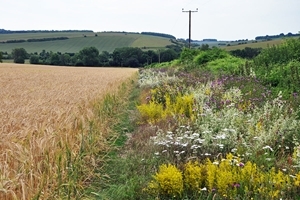 These days farmers face many pressures including producing more food sustainably, and using more natural ways of controlling pests now key insecticides have been banned. Planting wildflower margins can help; they can support pollinators and pest natural enemies, sequest carbon, and brighten up the landscape. However, they can be tricky to establish and manage to stop them degenerating into a weedy mess. Here are a few basic principles that can help.
These days farmers face many pressures including producing more food sustainably, and using more natural ways of controlling pests now key insecticides have been banned. Planting wildflower margins can help; they can support pollinators and pest natural enemies, sequest carbon, and brighten up the landscape. However, they can be tricky to establish and manage to stop them degenerating into a weedy mess. Here are a few basic principles that can help.
Location
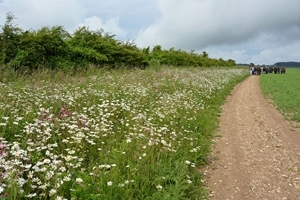 Select sites that don’t have existing noxious weeds problems or that are near to them. Less fertile soils are better to discourage grasses that can quickly swamp broadleaved plants, and choose sunny spots away from woodland with hungry deer. The wider the sown area the better to avoid ingress from the edges.
Select sites that don’t have existing noxious weeds problems or that are near to them. Less fertile soils are better to discourage grasses that can quickly swamp broadleaved plants, and choose sunny spots away from woodland with hungry deer. The wider the sown area the better to avoid ingress from the edges.
Seed choice depends whether a particular group of beneficial insects needs to be encouraged. At its most simple, this could be flowers with deep corollas to support long-tongued bees, or those with simple open flower structures allowing access to the nectar and pollen by short-tongued bumblebees, solitary bees and hoverflies. There are also mixes designed to support pest natural enemies and especially parasitic wasps (see tables of suggestions below). Selecting plant species appropriate for the soil type and climate is also essential, and some seed companies will tailor mixes to your conditions. If they already occur in other areas on the farm, this is a good guide to their likely successful establishment, or locally sourced green hay is another option. Grasses can be included but usually establish anyway.
Establishment
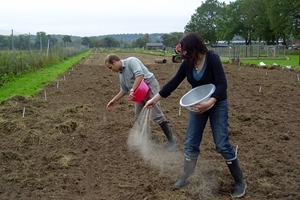 Weeds are one of the greatest threats so repeat the process of cultivating and letting weeds emerge as many times as possible before broadcasting on to a fine seedbed then roll.
Weeds are one of the greatest threats so repeat the process of cultivating and letting weeds emerge as many times as possible before broadcasting on to a fine seedbed then roll.
Sow when warm and into a moist soil, which can be March/April or August/September or in between, avoiding dry periods. Seed companies can advise on seed rates for the site conditions.
Management
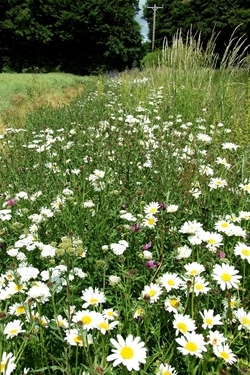 Mow to 4-5cm several times during the first year as soon as annual weeds are starting to dominate, though not if yellow rattle has established. Remove cuttings if there’s a lot of debris or mow more frequently and leave them. In following years cut annually – July/early August is best to encourage flowering plants. Avoid cutting all areas at the same time to ensure that flowers are constantly present somewhere. Removing the cut vegetation is critical otherwise the debris will smother those carefully nurtured and expensive wildflowers. Once a few areas have been successfully established then the green hay can be used to establish new areas.
Mow to 4-5cm several times during the first year as soon as annual weeds are starting to dominate, though not if yellow rattle has established. Remove cuttings if there’s a lot of debris or mow more frequently and leave them. In following years cut annually – July/early August is best to encourage flowering plants. Avoid cutting all areas at the same time to ensure that flowers are constantly present somewhere. Removing the cut vegetation is critical otherwise the debris will smother those carefully nurtured and expensive wildflowers. Once a few areas have been successfully established then the green hay can be used to establish new areas.
New research has shown that we need to include more weed species to support wild bees than traditionally thought, so leaving scruffy areas or allowing weeds to survive in the crop also has value. Top weeds are bristly oxtongue, corn poppy, charlock, dandelions, dead nettles (lamium species), perennial sow-thistle, smooth hawksbeard, scentless mayweed and bindweed. Many hedgerow plants are also valuable and should be encouraged such as hogweed, angelica, wild parsnip and primrose.
| Bumblebees |
Solitary bees |
Pest natural enemies |
|
Traditional mix
- Common knapweed (Centaurea nigra)
- Birdsfoot trefoil (Lotus corniculatus)
- Red clover (Trifolium pratense)
- White clover (Trifolium repens)
- Alsike clover (Trifolium hybridum)
- Oxeye daisy (Leucanthemum vulgare)
- Sainfoin (Onobrychis viciifolia)
- Musk mallow (Malva moschata)
Also add
- Kidney vetch (Anthyllis vulneraria)
- Meadow crane's-bill (Geranium pratense)
- Greater knapweed (Centaurea scabiosa)
- Wild marjoram (Origanus vulgare)
- Rough hawkbit (Leontodon hispidus)
|
- Common knapweed (Centaurea nigra)
- Dandelions (Taraxacum species)
- Red bartsia (Odontites vernus)
- Catsears (Hypochaeris radicata)
- Fleabane (Pulicharia dysenterica)
- Yarrow (Achillea millefolium)
- Wild carrot (Daucus carota)
- Pignut (Conopodium majus)
- Rough chervil (Chaerophyllum temulum)
- Hedgerow crane’s-bill (Geranium pyrenaicum)
- Primrose (Primula vulgaris)
|
Perennials
- Fennel (Foeniculum vulgare)
- Tansy (Tanacetum vulgare)
- Yarrow
- Perennial cornflower (Centaurea montana)
- Oxeye daisy
- Birdsfoot trefoil
- Red clover
- White clover
- Bush vetch (Vicia sepum)
Annuals
- Cornflower (Centaurea cyanus)
- Borage (Borago officinalis)
- Phacelia
- Common vetch (Vicia sativa)
- Red dead nettle (Lamium purpureum)
- Buckwheat (Fagopyrum esculentum)
- Bishopsweed (Ammi majus)
- Viper’s bugloss (Echium vulgare)
- Teasel (Dipsacus fullonum)
|
Further information
- Nichols, R.N., Goulson, D., Holland, J.M., (2019) The best wildflowers for wild bees. Journal of Insect Conservation, 23: 819–830.
- Wood, T.L., Holland, J.M. and Goulson, D. A. (2017) Providing foraging resources for solitary bees on farmland: current schemes for pollinators benefit a limited suite of species. Journal of Applied Ecology, 54: 323-333.
- Nowakowski, M. & Pywell, R.F. (2016) Habitat Creation and Management for Pollinators. Centre for Ecology & Hydrology, Wallingford, UK.
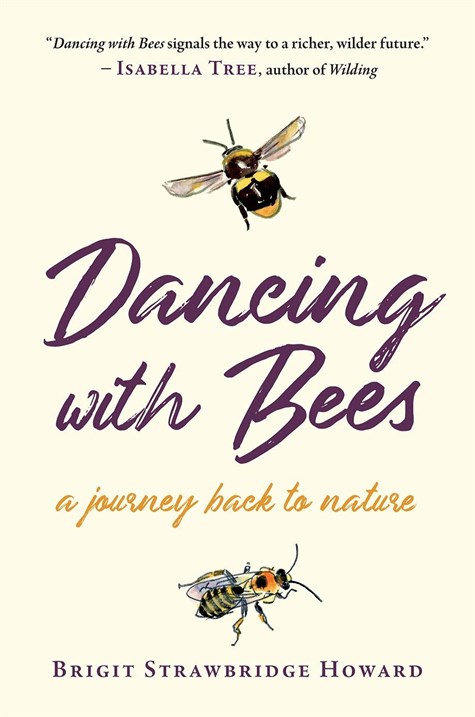
Dancing with Bees: A Journey Back to Nature
Dancing with Bees is Brigit Strawbridge Howard’s bestselling, charming and eloquent account of a return to noticing, to rediscovering a perspective on the world that had somehow been lost to her for decades and to reconnecting with the natural world .
View Book >